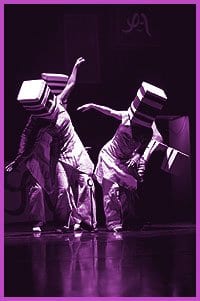Compagnie kafig, a French-based dance company of broad European acclaim, will bring Ottawa a spicy mix of street hip hop and stylized choreography in the North American premiere of Corps est Graphique.
“Compagnie Kafig’s shows are for everyone,” says artistic director Mourad Merzouki. “Corps est Graphique releases hip-hop energy through contemporary writing. Kafig tries to elevate hip hop dance from the street to the stage with costumes, decorations and lighting.”
Eight French Algerian dancers combine hip hop with stylized French, North African and Andalusian choreography. Kafig adds an energized mix of capoeira, mime and gymnastics that compels and stuns audiences.
“Everywhere in the world,” says Merzouki, “audiences have received us with lots of surprise. This has always been positive. Our popularity comes from addressing a very large public – from age 7 to 77, as well as different classes, cultures and generations.”
Enthusiastic critics describe Kafig as a Euro-version of the Beastie Boys because of their coverall body suits that resemble mechanics’ uniforms and their toe-worn Adidas sneakers. The company has made the rounds worldwide, from Tanzania to Mexico. Kafig last visited Canada in spring 2002 to perform 10 Versions at Toronto’s Harbourfront Centre, but has never performed in Ottawa. Kafig will also tour Montreal in late February.
“It is important to us to take artistic opinions and build a Franco-Canadian exchange,” Merzouki says.
Merzouki has built an exchange between unlikely styles since entering the hip hop scene at age 17. In the 1980s, European minorities embraced hip-hop dance as a way to confront harsh social conditions such as welfare, crime and racism. While Kafig does not delve into social problems, its does refer to them. In 10 Versions (2000-2001), both the title and French lyrics play with the idea of diversity – the acceptance of every color of the rainbow and every shape and size. The music also asks: “So what is our job in this sacred universe?”
Merzouki, inspired by hip hop, tried to raise this improvised street style to the stage. In 1989, he co-founded the dance company Accrorap, and learned from contemporary choreographers such as Joseph Nadj, Maryse Delante and Jean François Duroure.
In 1995, Merzouki left Accrorap and founded Compagnie Kafig, fusing genres and establishing hip hop as its own artistic language, with a different style and vocabulary than other contemporary dance. The production of Kafig & Generation Hip-Hop in 1996 was an expression of the freedom and energy of hip hop versus ordinary, everyday life. The philosophy behind it was learning from each others’ differences without losing one’s sense of roots.
“Kafig practices all techniques,” Merzouki says, “originating from hip-hop, break, smurf, new style dance and integrates them into a theme choreography.”
For Corps est Graphique, Merzouki received carte blanche from Guy Darmet, a director with Maison de la Danse de Lyon, who had followed the young dancer’s artistic progress. Mourad united four female and four male dancers to make a performance about the links between bodies and their designs without distinction of gender.
“The company tries to thrive on an open-mindedness,” says Merzouki, “in order to raise a subculture born on the street. Our exchanges with the public are very important. Kafig uses dance as an artistic tool to communicate.”
COMPAGNIE KAFIG.
Corps est Graphique.
Tue, Feb 17 and Wed, Feb 18.
National Arts Centre.
8:30pm.
947-7000.

 Why you can trust Xtra
Why you can trust Xtra


